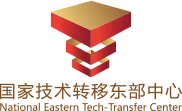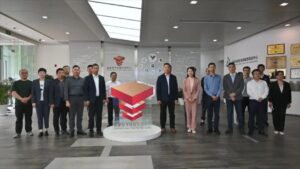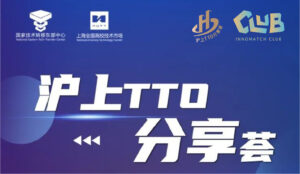summary
The growth of the balcony is a microcosm of Shanghai's private technology intermediary service providers. A year ago today, the municipal government issued the Opinions on Accelerating the Construction of a Science and Technology Innovation Center with Global Influence, proposing to "promote the development of science and technology intermediary service clusters". Under the guidance of the "22 Opinions" and its supporting policies, a number of multi-model, high-level private service providers have taken root in Shanghai and grown rapidly.
In June last year, Wei and his Tsinghua classmate, Dr. Zhang Cheng, and others met at the IFC balcony to discuss entrepreneurship and proposed to build a "Shanghai WSGR (Silicon Valley's leading law firm)" to provide IP-centric services to technology-driven enterprises. Today, the company has been established for more than half a year and is promoting the transformation of an achievement of the Shanghai Institute of Biological Sciences, Chinese Academy of Sciences.
The growth of the balcony is a microcosm of Shanghai's private technology intermediary service providers. A year ago today, the municipal government issued the Opinions on Accelerating the Construction of a Science and Technology Innovation Center with Global Influence, proposing to "promote the development of science and technology intermediary service clusters". Under the guidance of the "22 Opinions" and its supporting policies, a number of multi-model, high-level private service providers have taken root in Shanghai and grown rapidly.
Tsinghua students start up business to help translate results from early cancer screening
The transfer and transformation of scientific and technological achievements is an important issue in the construction of Shanghai Science and Technology Center. How to make up for this short board? It requires the joint participation of multiple subjects such as enterprises, universities, research institutes and intermediary service agencies. Among them, intermediary service agencies play an important role in the transformation chain and are the bridge between the laboratory and the production line.In Silicon Valley, the technology intermediary service industry is well developed, and WSGR Law Firm is one of its representatives, providing legal services including IPR and IPO for high-tech companies.After leaving WSGR's Shanghai office, Zhang Cheng felt that Shanghai needed a group of technology-driven companies with global impact to become a science and innovation center. The purpose of founding Balcony is to discover the Apple and Google of the future and help them grow.
Terrace co-founders Guozhu Wei (center), Hang Zhang (right), and Zaizhao Wang Courtesy of Terrace Inc.
A genomic high-throughput sequencing result from the Shanghai Institute of Biological Sciences, Chinese Academy of Sciences, is a project that Terrace is promoting for translation. This lab result, if industrialized, could be used for early screening of certain tumors. And to achieve industrialization, it must go through validation and improvement, a small pilot test, and submission to the Food and Drug Administration for approval. The large capital investment and time-consuming process are the main obstacles to the transformation of such biomedical results. In order to reduce the cost and speed up the transformation, the balcony initiated the "molecular diagnostic platform" project, which received several million angel investment. Today, the project is under implementation, a clean plant in line with the relevant national norms will be completed in Zhangjiang. If the CAS team's validation and improvement results are satisfactory, trial production can be carried out in the plant. As the "molecular diagnostic platform" can undertake the transformation of other biomedical results, the cost of conversion of individual results will be significantly reduced.
In addition to building the platform, the Terrace team also plans to patent the CAS results, assist in their financing, and promote the early introduction of early cancer screening technology into the clinic.
Create an innovative and functional platform with the first technology transfer innovation voucher
To Wei's delight, Terrace recently received a $140,000 innovation voucher subsidy. They signed a contract with a manufacturing company that wanted to transform and upgrade their business to do a competitive intelligence analysis of silicon cutting equipment for the latter. This contracted project was evaluated and publicized by experts organized by the Eastern Center for National Technology Transfer, and received innovation voucher support - the manufacturing company paid $140,000 worth of innovation vouchers to the terrace as part of the contract payment; the terrace cashed in the vouchers to the Eastern Center.
According to the report, the Shanghai Science and Technology Commission this year launched the country's first innovation voucher for technology transfer and technology consulting, entrusted to a third party, the Eastern Center, to operate and manage.Intermediary service providers can apply for innovation vouchers from the Centre after reaching an intention to cooperate with technology-based enterprises. If the vouchers are evaluated and publicized by experts, the service provider can receive a certain percentage of the subsidy, up to a maximum of RMB 300,000.
While operating and managing innovation vouchers, the Eastern Centre is also renovating the city's first technology transfer services creation space. Next month, startups such as Terrace, Yumo and Cloud Hatching will be based there. "Yumo specializes in international transfer of clean technology, Cloud Hatch has a lot of resources from universities and research institutes, and we specialize in intellectual property services. These companies getting together will help exchange cooperation and expand customers," Wei Guozhu said.
Shou Ziqi, director of the Municipal Science and Technology Commission, said that in the process of building a professional technology transfer service system, the relationship between the government and the market should be handled well, fully reflecting the decisive role of the market.To this end, Shanghai has positioned the Eastern Center as a "functional platform for innovation", shifting from the original "peer-to-peer" government funding approach to a "platform" funding approach.
Wan Gang, Vice Chairman of the CPPCC National Committee and Minister of Science and Technology, and Zhou Bo, Vice Mayor of Shanghai, unveiled the plaque for the Eastern Center. Source: Shanghai Municipal Science and Technology Commission
The Eastern Center, jointly promoted by the Ministry of Science and Technology and the Shanghai Municipal Government, was inaugurated in April last year in the Bay Valley Technology Park. With the government's support, the center started in Shanghai and has established 50 technology channels in the Yangtze River Delta region, Gansu, Xinjiang, as well as Singapore, the Netherlands, the United Kingdom, the United States and Russia, and set up five domestic branch centers as well as branch centers in North America, Europe and Singapore. As a functional platform for innovation, the Eastern Center has gathered 56 market-oriented and professional science and technology intermediary service institutions, most of which are private enterprises, and their services include technology search, intellectual property operation, science and technology strategic planning, chief technology officer training and other eight types of services.
Inviting more people to participate in technology transfer, drawing on the sharing economy
Shou Ziqi analyzed that among these intermediary service agencies, Terrace and Yumo belong to the professional service model, that is, they pursue to be refined, deep and specialized in the whole process or certain aspects of intellectual property management and technology transactions.One of the main features of this model is that it has a strong talent spillover effect from multinational companies: the core team members often have long-term experience in multinational companies, and many of them have doctoral degrees. They localize the concepts and models of science and technology transfer services of developed countries, overcoming the weakness of foreign-funded service organizations that are "unsuited to the soil and water".
There is also a model for technology intermediaries - the platform-channel type, the main feature of which is to build an online platform to facilitate the matching of supply and demand for technology, and to provide offline services for docking projects.Shanghai Maitan Information Technology Co., Ltd. is a representative of this company, which was founded at the end of 2014 and was founded by five Shanghai Jiao Tong University alumni.They get their money from "sharing economy" products like Uber.As a profitable business, technology trading can attract more people to participate. To this end, Maithan established the "Maithan Technology" online platform, inviting people with enterprise resources or knowledge of technology from all walks of life to register, share information and become "project partners". For the technology and enterprise needs released by the partners, Maitan will analyze them, look for technologies with market value and needs common to the industry, and hire industry technology experts to assist in the research and judgment. Last year, Maithan successfully docked 134 technology demands, and the contract amount directly involved reached 32.8 million RMB.
"Mai Tech" platform invites users to register as project partners. Source: MyTek website
When it comes to the profit model, the company's co-founder, Si Van Li, said that if the companies and researchers make a deal by matching information on the platform, they won't charge for it; if they get their information hosting, technology improvement, venture capital introduction and other offline services in the technology transfer process, they will charge or take up shares.
The latter was the case recently when Maitan turned an idea for a new air purifier into a product through in-depth services. The origin of this project was a corporate R&D staff member who posted a design concept for an air purifier on the "Maitan Technology" platform, seeking technical support. After analyzing the idea, the Maitan team found the innovative design feasible and contacted the Shanghai Research Institute of Chemical Industry and other organizations to develop the technology and make a prototype. Maitan also helped research and development personnel to introduce external funds, set up enterprises, and signed an intentional supply and marketing contract with several well-known domestic enterprises. Li Si-vanadium revealed, "We are preparing to build Mai science and technology industry promotion fund, the scale is expected to be about 50 million yuan. Once the fund is established, it will be able to invest in more technology solutions with market prospects, and the return on investment will become the main profit model for Maithan."
Source:Internet Photo Editor:Zhu Li
Source: Shanghai Watch








